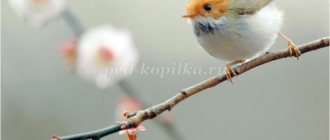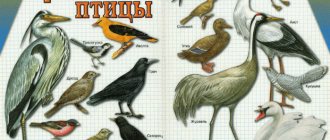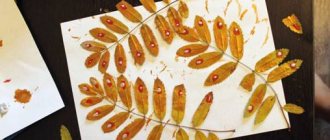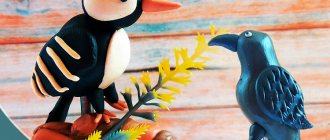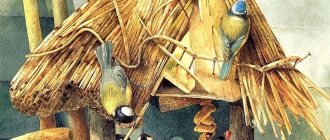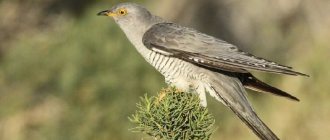What training materials will be needed during the process?
The brighter and more diverse the story about nomadic birds for kindergarteners is, the more it will remain in memory. When preparing, I recommend using your senses as much as possible: eyes, ears and fingers. This means that we will watch pictures and videos, listen to information and poems about birds, and touch feathers with our hands.
The first and most important aid that we use in class is the “Birds of Migratory” poster. It shows all the necessary views, the pictures are large and visible from afar. The birds are well drawn and it is easy to explain from them how one differs from the other (tails, wings, legs, plumage, size). The birds are signed, the most inquisitive children will try to read them.
Flashcards with migratory birds are also very helpful. They have three purposes at once: you can take poems and riddles from the card, and learn the bird’s name in Russian and English. But most importantly, using the cards we give the task to compose a story: describe what wings, legs, color of plumage, etc. the bird has. For example, the presenter talks about the first card. There are also other cards without names. We give them in the second lesson and check recognition.
We look for poems in which lark, swallows, starlings, nightingales, thrushes, storks, rooks, cranes and other birds appear on the Internet or in special teaching aids. There are also fairy tales on the Internet that are interesting for children 6 years old. For example, “On the Lake”, “How Sparrow looked for Africa”, “Returning to the Homeland” and others.
It’s great when you have the opportunity, after a poem or fairy tale, to show a video in which a bird flies, walks, and feeds. You can try to find videos on the Internet and edit short videos, no longer than a minute. There are educational films, video tutorials and educational videos about migratory species on Youtube. But they take time; it’s better to show such a film outside of class. You can watch the cartoon: “Grey Neck”, “Heron Mother”, “Quacked Vacation”, “Flap Your Wing”.
Owl
The eagle owl is the largest bird among the owls, its height is 0.6–0.8 m, its wingspan is up to 1.9 m. It is distributed throughout Eurasia, except the far north. Hunts by planning. It is a wintering sedentary species.
The plumage is motley, brown tones, loose, absorbs the sounds of flight. There are feathers sticking out on the head, like “ears”. The paws are completely covered with feathers, the claws are large. Amber eyes stand out on the facial disc. During courtship, partners call each other loudly, forming permanent pairs.
Thanks to the special structure of the spine, the eagle owl's head can even turn backwards.
Hunts in the evening all night. It feeds on rodents, hares, birds, frogs, and fish.
Nests are located on the ground, in the roots of trees, among brushwood. The female incubates, the male feeds her and the chicks. The chicks are covered with down and blind. At 2 months they begin to fly, at 3–4 months they leave their parents.
Rice. 3. Eagle owl.
What to tell children about migratory birds
The main point of the lesson is to tell that birds are living creatures with warm blood. Their body temperature is higher than human, about +41 degrees. To be able to survive the winter cold, birds need a lot of energy. This means more food is required.
Insectivorous and carnivorous birds have nothing to eat in winter, and they fly south to warm countries. Waterfowl are also forced to fly away, because the water in which they look for food freezes. Cranes eat berries, storks and herons eat frogs; in cold weather they also have nothing to eat. Some species that prefer plant foods also fly south. Granivores have one peculiarity - they do not always leave our latitudes.
Birds that fly away for the winter are called migratory or nomadic. And those who remain to spend the winter in their native country are sedentary (wintering). Geese, swans, herons, storks, nightingales, siskins, rooks, starlings, swallows, quails, larks, blackbirds, and orioles go to winter. They move to different countries. Quails - to Africa and Asia, nightingales - to Africa, siskins - to Kazakhstan and the Caucasus. Wintering species include crows, titmice, sparrows, pigeons, magpies, and other species.
They fly in flocks or wedges, and some fly alone (cuckoos, hawks, falcons). In the spring, migratory birds travel back to their native lands to raise their young. They are very useful for nature and humans. Insectivores eat insect pests, while others help maintain the ecosystem. For example, storks eat snakes and locusts.
Kindergarteners will love these fun facts. That birds fly south in a flock, in a direct front, in a wedge or in a school. You can show what it looks like in a presentation or photo. There are folk signs and riddles about migratory birds. Feathered travelers remember their nests and fly there from year to year. Departure time varies: birds make decisions based on the weather and instincts (be prepared to explain what these are). It cannot be otherwise, because they do not read newspapers.
Birds
The first heralds of spring - rooks - arrive in March. They walk slowly and importantly through the snow-free fields, collecting larvae and worms. The rook is easy to recognize. The old rook has bright black plumage and a white patch around the beak. This is what old rooks look like. But young people don’t have such a spot. Spring sowing is underway in the fields. Following the tractors and seeders, rooks walk along the furrow, collecting insects. Not immediately after arrival they begin to build their nests. Rooks usually settle in large groups on tall trees. This is a colony of rooks. The place where these birds settled can be immediately recognized by the strong noise and scream.
Following the rooks, the first larks arrive in March, followed by starlings. The birds do not all arrive at once. First, the first single birds arrive. And after the advanced detachments of rooks and starlings, other birds fly. At the end of March the first larks or starlings arrived, and then there were blackbirds, lapwings, gulls, ducks, swans and other birds.
Migratory birds are in a hurry to get to their native places, build a nest, and raise their chicks.
How do our old friends, the wintering birds, live in the spring? And in the spring they begin to worry about raising chicks.
Spring... A joyful, bright time of year. But for many animals and birds, spring is the most difficult, difficult time and, above all, the hungriest time. The supplies collected in the fall have come to an end; during the long winter, seeds, acorns, berries, nuts, and mushrooms covered under the snow have been eaten. The bark from young aspen and mountain ash trees was gnawed. Upholstered with cones from fir trees. It just seems that the forest is an inexhaustible storehouse. In fact, by spring there is little edible left.
How to create a lesson plan
If this is your first lesson on birds, you need to make a detailed list of what you will tell and show, in what sequence, and make a timeline. It is important where you decide to conduct the lesson - outdoors or indoors. In nature you can hear and sometimes even see birds. But indoors you can watch videos and cartoons. This thematic guide will help you plan a lesson with a descriptive part, games and other tasks.
It is difficult to tell a child about something he did not see. Therefore, kindergarteners need to be shown drawings and videos, and given recordings of birdsong to listen to. By the way, another manual with pictures of migratory and wintering birds, as well as domestic and wild ones. It will help tell you about domestic, forest, waterfowl and other species. Don’t forget to explain that birds live in birdhouses, nests, and hollows. Even better – show it during a walk.
You can build a lesson for kindergarten in the form of a dialogue: ask questions and tell stories. For example: “What season is it now? The days have lengthened and other changes have occurred (list). Have you heard birds singing in the morning? Those who have returned from warmer climes sing - migratory birds. Do you know who migratory birds are?” It is worth mentioning the nomadic birds that come to us for the winter because they are accustomed to the cold (bullfinches, tits).
You can divide the lesson into two or three parts. But do not give them one after another, but take a break of several days. Children need to digest, “live” the information, tell their parents and friends about new knowledge, and discuss it.
One of the lessons can include games for speech development. For example:
- Name the chick (cuckoo - cuckoo, rook - rook, etc.).
- Find the odd one out (choose a non-migratory bird from three or four).
- Call it affectionately (cuckoo - cuckoo, feather - feather, wing - wing, nightingale - nightingale).
I recommend including a variety of games and entertainment in your lesson plan. For example, coloring books and stickers with birds, children's lotto or other games with images of birds, simple origami, finger games. You can give tasks on cards: for example, arrange them in two rows - with migratory and wintering birds.
Migratory birds in spring
Oh, how nice it is in the forest! Smells like spring. The snow is melting, the first insects appear. Trills, chirping and birdsong can be heard. After all, the birds that flew to warmer regions in the fall return to their homeland. They enjoy the warmth and sunshine.
Rooks are among the first to arrive. This usually happens in March.
In the old days they said: “If you see a rook, welcome spring!”
The rook is a large black bird with a purple tint. It looks like a carrion crow, but the rook's beak is lighter and the skin around the beak is devoid of feathers. The rook can be up to fifty centimeters in length. Rooks usually live in large colonies, with several dozen nests on one tree.
Rooks build their nests from twigs, lumps of clay, moss, and dry grass.
Rooks communicate with their relatives by cawing loudly.
Starlings follow the rooks. Among the people there was such a sign: “If you see a starling, you know spring is at the porch.”
The starling is a small but very beautiful bird. Its black feathers have a metallic reddish, purple, greenish sheen. There are also white spots scattered here and there.
Everyone knows that starlings are useful birds. They walk on the ground with their heads down, looking for food. With their long beaks they grab beetles, weevils, caterpillars and other insects.
When starlings arrive, people make houses for them - birdhouses. But starlings can also settle in tree hollows and in the voids of outbuildings.
The starling's spring song is good. What sounds can you hear in his song! Starlings can imitate the voices of many birds and animals. In the singing of a starling you can hear the ringing trill of a nightingale, the quack of a wild duck, and the croaking of frogs.
In the old days in Rus' it was believed that birds brought spring on their wings. There was a custom in March to sculpt and bake lark birds from dough. They were attached to long sticks, the children ran out onto the hills with them and sang Russian folk songs:
Larks, come, take away the cold winter, bring the warmth of spring: We are tired of winter, we have eaten all our bread!
A lark is a bird slightly larger than a sparrow. The lark's feathers are grayish-brown, with dark stripes and spots. And the tummy is light. There is a small crest on the head, and the tail is edged with white feathers.
This coloring makes the lark invisible among tufts of grass and plant stems. After all, larks build their nests right on the ground, among the grass.
Larks arrive at the end of March - beginning of April, when the snow begins to melt.
The fields have not yet turned green, but the larks in the blue sky are already fluttering their wings and singing joyfully. Their song sometimes resembles a trill, sometimes like the ringing of bells.
In April, another small bird arrives - the wagtail.
Why did the wagtail get such a strange name? Running on the ground, she constantly shakes her tail with a long tail. The tail is the back part of the body of birds. There is a popular saying: “a wagtail breaks the ice with its tail.” After all, these restless birds arrive when the ice on the rivers begins to break. That is why the wagtail is called an icebreaker.
The song of wagtails is melodic, but simple. Male wagtails sometimes chirp quietly, sometimes squeak quietly, sometimes chirp loudly.
But this brightly colored bird is a finch. The top of his head is bluish-blue, and his chest is light red. But why was the chaffinch called a chaffinch? Maybe because he is freezing, that is, chilly? Not at all. The finch simply flies away in late autumn and arrives in early spring, when it is still very cold and chilly outside.
Finches are not afraid of anything. They can look for food right under a person's feet. And when they sing their wonderful songs, they don’t notice anything or anyone around them. There is a Russian saying that the lark sings for warmth, and the finch sings for frost.
Blackbirds also arrive in April.
Blackbirds usually make their nests on small spruce trees or on juniper bushes. And sometimes even on the ground, in piles of brushwood. There the female lays from three to six bright blue eggs with sparse dark specks.
Song thrushes are considered remarkable singers. Their singing resembles the trills of a nightingale.
In April, other migratory birds also arrive: kites, swans, geese, ducks, herons, cranes, and little warblers.
But in May, swallows, flycatchers, nightingales, orioles, and swifts arrive from warm countries.
For a long time, people have had a special attitude towards the swallow. There are many beliefs associated with it. People say: “An early swallow means a happy year.” A house with a swallow's nest is considered lucky.
Urban white-breasted swallows make their nests under the eaves of stone and wooden houses. Killer whale swallows nest under the roofs of village barns and houses. Shore swallows are found in burrows, which they dig with their sharp claws in the steep slopes of the river bank. Swallows spend almost their entire lives in flight. They very rarely fall to the ground, because their short legs are not adapted to walking on the ground.
The swallow has an elongated body, narrow long wings and a long forked tail.
The chirping of swallows is difficult to hear in the city. Her voice is quiet. And from time to time the chirping is replaced by crackling.
But the nightingale is rightly called one of the best singers. Looking at this small, inconspicuous bird, it is difficult to believe that such wonderful sounds can be produced from such a fragile body. The nightingale is small, but the voice is great.
The nightingale is a very slender, graceful bird, painted in uniform reddish-brown tones. He has rather high legs and a graceful figure. The nightingale has very large dark, almost black eyes.
But this bird is slightly larger than a starling. Look how bright the yellow plumage is! And the wings and tail are black. Moreover, there is a black stripe from the beak to the eyes. And the beak is reddish. This is a male oriole.
But the female oriole looks more modest. Her feathers are not bright yellow, but greenish.
Orioles are wonderful singers. Their singing resembles the sounds of a flute. But sometimes an oriole, worried about something, makes unpleasant sounds reminiscent of a cat meowing.
The swifts arrive later than everyone else. Swifts can be seen in almost every corner of the earth, except Antarctica and several islands. These birds are very similar to swallows. Sometimes they are even confused. But distinguishing a swift from a swallow is quite simple. Swallows have a white breast, while swifts have only a white spot under the beak. The wings of a swift are longer and narrower than those of a swallow. But the tail is wider and shorter.
The swift is the champion among all birds in terms of flight speed. It can reach speeds of up to one hundred and seventy kilometers per hour. But on the ground, these incomparable flyers waddle with difficulty on their short legs, helping themselves with the ends of their wings.
Swifts fly over houses with loud, piercing screams. They seem to tell everyone that warm summer weather has arrived.
Yes, what wonderful creatures birds are!
Questions and conclusions about the lesson
To consolidate the information, I recommend asking the following questions at the end:
- What are migratory birds?
- Where and why do they fly away for the winter?
- What kind of birds fly to southern areas (names)?
- Do chicks travel with their parents?
- Why do they return back from warmer climes?
- Why do they fly in flocks?
- What do migratory birds eat?
- What benefits do they bring to people and nature?
“Bird” activities will help enrich your horizons, expand your knowledge about the surrounding world and nature, and give new names and concepts to your child’s vocabulary. They will tell you how diverse and interesting the world is. First of all, they will give an understanding that birds are living beings, they need to eat and protect themselves from the cold, and raise their chicks. Migratory species are very important to the living world and human activities.
There is life in the air. Stories about it are very important for a modern urbanized child who sees nature briefly and in small quantities. Good luck with your studies and inquisitive children!
Bluethroat
The bluethroat is a sparrow-sized bird with a blue spot on its chest with a bright red edging. It is observed throughout Russia. Settles along rivers in bushes. It makes nests from blades of grass on the ground, in piles of branches. The eggs are incubated by the female and the chicks are fed by both parents. After 2 weeks, the babies leave the nest and are fed by their parents for another week.
It feeds on insects and larvae, which it collects on the ground or tree branches. In autumn, berries are added to the menu.
At the end of summer, bluethroats fly singly to Africa and South Asia.
Rice. 2. Bluethroat.
